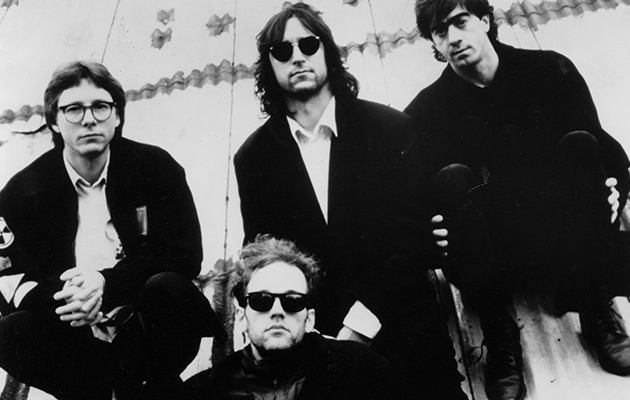14 WHAT’S THE FREQUENCY, KENNETH?
From the 1994 album Monster. Released: September 1994.
Chart positions: UK No 9, US No 21
Largely composed by Mike Mills, “What’s The Frequency, Kenneth?” takes its titular cue from a bizarre incident in which US news anchorman Dan Rather, while out walking on Park Avenue, was chased by a stranger who, as he rained blows on him, kept repeating the phrase: “Kenneth, what’s the frequency?” The attacker was thought to be one William Tager, who actually murdered a TV stagehand and was imprisoned in 1994. Believing the media to be beaming messages into his head, and believing Rather to be called Kenneth, he was supposedly demanding of him the frequency being used to transmit the waves. Stipe and co use this as a springboard, an almost inappropriately upbeat rocker, tidal in its exuberance and matched by a video in which Stipe and Mills in particular came on as almost studiously extrovert. All this is cover, however, for a digressive and introverted lyric at odds with its musical setting.
MIKE MILLS: It is an exuberant song but it’s actually complex, even musically. It’s quite deceptive, the way the chords go round – it sounds very smooth, sounds like it’s going the way it should go, very free-flowing, but if you were to break it down, figure out the chord structure, you’d realise there’s a lot of changing back and forth that you don’t necessarily hear when you’re listening to the song.
MICHAEL STIPE: The “Kenneth” thing, that’s just one line of the song. It happens to be a great title! We ended up singing that song with Dan Rather on David Letterman’s show. He has a great sense of humour, very self-deprecating. Also, he lets you see the guy behind the anchorman. He shows you he’s just an actor – well, not an actor, just a guy doing his job. He’s not a world expert, just a conduit between you and the news, or somebody’s idea of the news. But he had a glint in his eye and I liked that.
PETER BUCK: “Withdrawal in disgust is not the same as apathy” – that, for me, is the big lyrical moment in that song. The title is kind of a catchword. But that line is where the heart of that song is.
______________________
13 POP SONG 89
From the 1988 album Green. Released: May 1989.
Chart position: US No 86
With a sizeable advance from Warners in their pockets, REM became all too aware of their status as almost-famous and of the expectations on them to haul themselves into the limelight. This they undertook with an element of caution, self-consciousness and playful irony that didn’t always sit well. “Pop Song 89”, however, which quotes heavily from The Doors’ “Hello I Love You”, subverted its own breeziness with a lyric that prefigures the dilemma-wracked “Losing My Religion”(“Should we talk about the weather?/Should we talk about the government?”) and an extraordinary video in which Stipe dances with three topless girls. Strangely, this disconcerted rather than thrilled US audiences – and the single was not a commercial success.
PETER BUCK: We actually wrote that in 1987 for our 1987 tour. I said to Michael, “Why are you calling it that?” And he said, “I don’t know, it’s a pop song, it’ll probably come out in 1989, so let’s call it ‘…89’.”
MIKE MILLS: The song itself is really not quite as ironic as the title. But it was good that we did two versions of the video. There’s one in which there are black bars across Michael and the girls’ chests as they’re dancing, and one without the black bars. MTV America would only play the one without the black bars.
MICHAEL STIPE: There was total satire in the videos. I had big hair like a lion and I knew I was going to shave it off – but I wanted to do that shimmy-shake thing with a bunch of girls, but have everyone be topless, break down that whole sexist thing. So I found three women who were cool, “Yeah, I’ll show my tits on TV, why not?” We were big, but not yet huge in 1989. Aside from London, in Europe we were sharing a bill with Gene Pitney, playing small venues of well under a thousand people. There were places we weren’t that popular then, there are places we’re not that popular right now, America being one of them!


